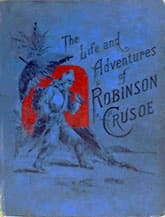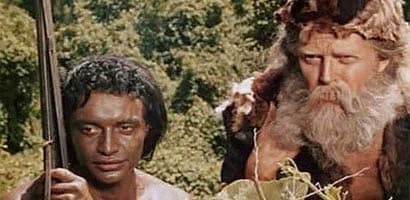Robinson Crusoe
Critique • Quotes • Text • At the movies
 1890 edition
1890 editionAlso known as
The Life and Strange Surprising Adventures of Robinson Crusoe of York, Mariner
First publication
1719, England
Literature form
Novel
Genres
Literary, adventure
Writing language
English
Author's country
England
Length
Approx. 140,000 words

Friday (Jaime Fernandez) and Crusoe (Dan O'Herlihy) protect their domain in 1954 adaptation.
Not everyone's desert island flick
Robinson Crusoe (1954): Also known as The Adventures of Robinson Crusoe; film, 89 minutes; director Louis Buñuel; writers Hugo Butler, Bunuel; featuring Dan O'Herlihy, Jaime Fernandez
As might be expected, Daniel Defoe's classic castaway adventure has been adapted into films and television shows. But probably not as many as you might expect.
More often the bare concept of a man (or woman) cast upon a deserted island, having to fashion the scarce natural supplies into housing, weaponry and food has been used for the basis of films without reference to the Crusoe tale. Or in some cases some variants on the names Robinson or Crusoe have been lent to stories that are completely different.
Perhaps filmmakers have been discouraged from faithful adaptations by the unsettling subtext of race, empire and the white man's burden in the Defoe novel. It's something to bear in mind as we peruse a sampling of the adaptations—which we'll see are a quite varied lot, the 1954 version being the best.
A passing adventure
Louis Buñuel is not a director one would expect to be drawn to this project, let alone to produce one of the most effective translations of the book. Considered a radical for his early, shockingly surrealistic films and for his later sophisticated comedies of social criticism, Buñuel was in his middle period of directing small-budget flicks on innocuous topics when Robinson Crusoe (1954) came along.
Buñuel strips the novel down to the island story. The picture, filmed in Mexico, opens with Crusoe's voice-over about being on a trip to get slaves as we see him being washed ashore. It closes with him and Friday preparing to leave the island after rescue.
In-between, the survival story is reduced to its basic elements. We experience the growth of Crusoe's encampment, his attempts to grow his own food, and his relationship with animals (both pets and food sources) without suffering through all the details.
Irish thespian Dan O'Herlihy, considered an actor's actor more than a popular star, is perfectly cast as Crusoe for this. He's able to portray with minimal histrionics the castaway's many moods and inner conflicts, and he ages believably from the young adventurer to the experienced ruler of his wild domain.
Trailer for Louis Buñuel's The Adventures of Robinson Crusoe in 1954.
Especially in the scenes with Friday (Mexican actor Jaime Fernandez, who would go on to have a long career in Spanish-language films and television), O'Herlihy is able to credibly portray the man with all the authoritarian traits of his time, as expressed in the novel. At the same time, he reveals the humane impulses needed to help us—in our time—identify with him.
Buñuel's film even ends up being uplifting, which is odd for him. In only three scenes are we treated to the director's own bleaker view of life. Once when Crusoe is ill and hallucinates his father (also played by O'Herlihy) scolding him for going against his wishes. Once when he erects a scarecrow and we see him wistfully enchanted by the female form the garments take. And once when he calls out for divine help and hears back only his own echo.
But these moments are fleeting, as is the whole film. Which is a good thing. Twenty-eight years pass in ninety minutes.
An improvement on the book.
— Eric

